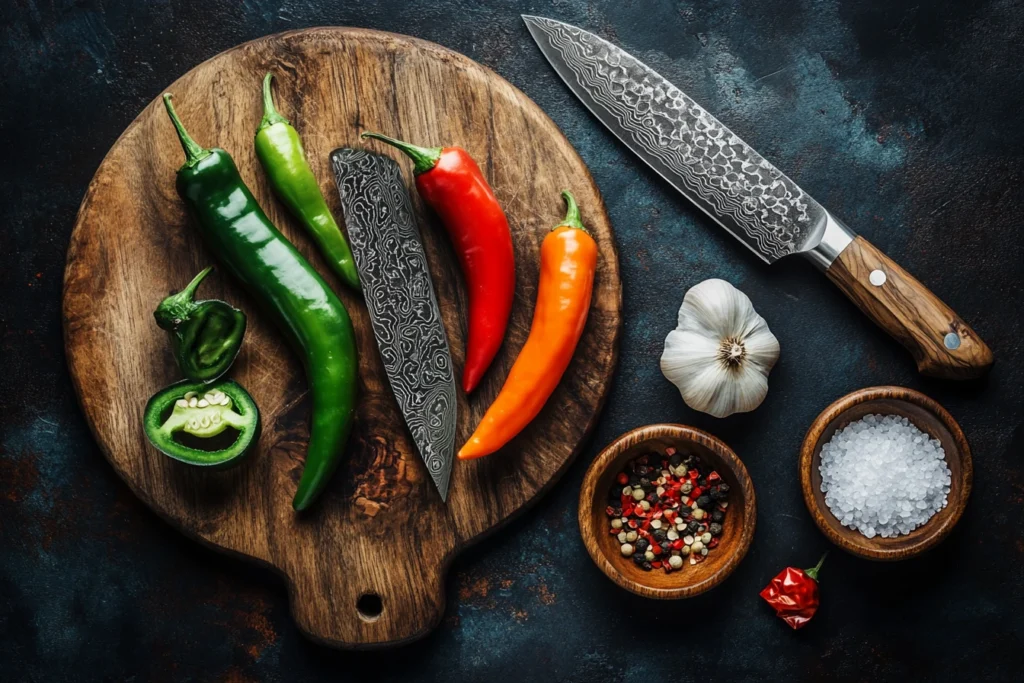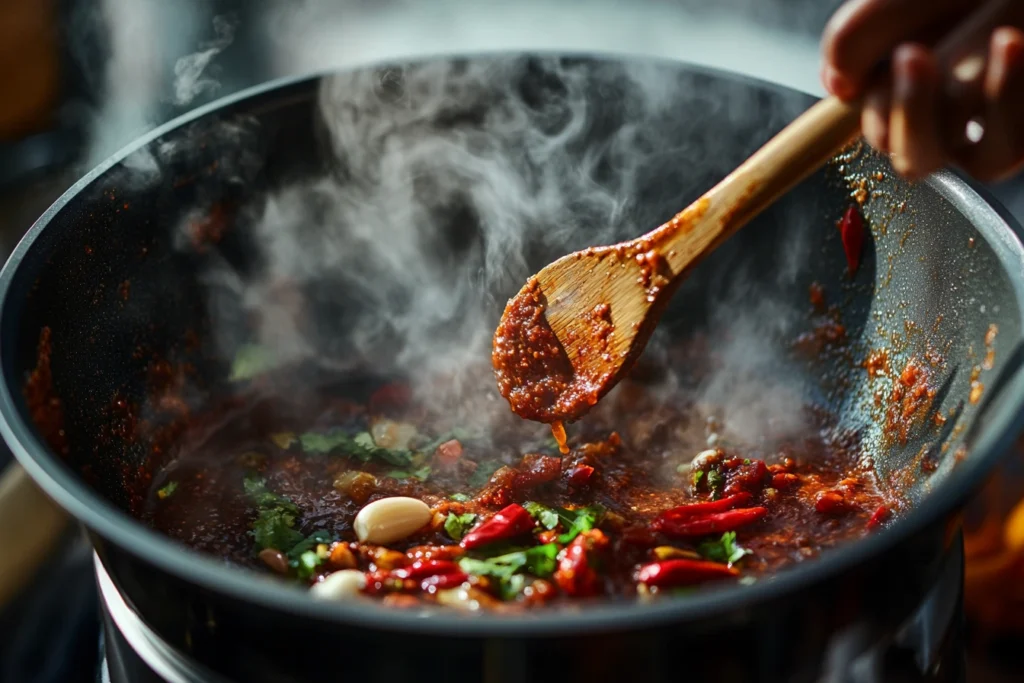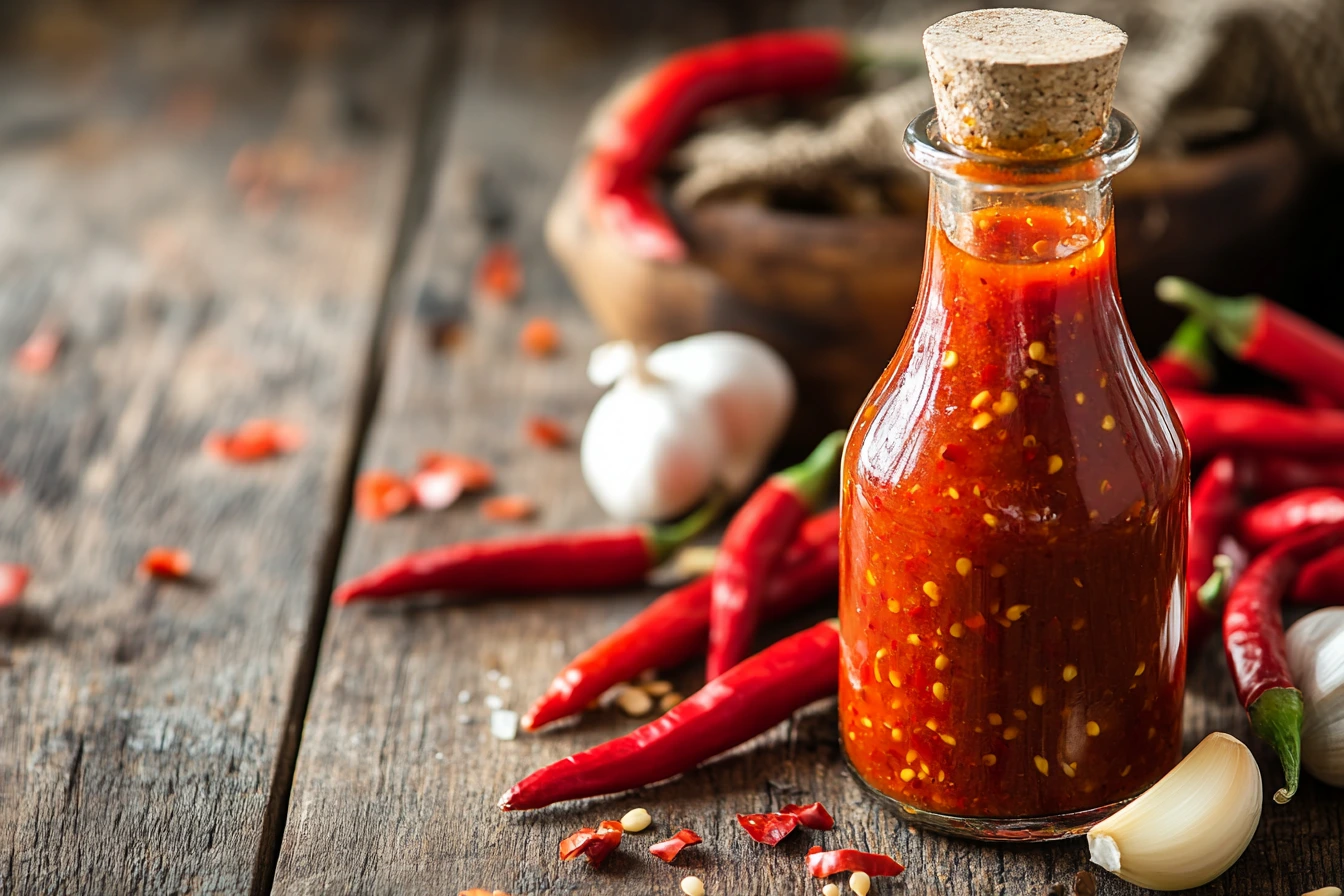Love a good kick in your food? Whether you’re a die-hard spice lover or just want to add some zing to your meals, a homemade hot sauce recipe is a game-changer. Store-bought sauces are great, but nothing beats the depth of flavor, freshness, and control you get from making your own. Plus, it’s way easier than you think!
In this guide, we’ll walk you through everything you need to know about making hot sauce recipefrom choosing the right peppers to nailing the perfect balance of heat and flavor. You’ll learn different methods (fermented vs. non-fermented), popular variations, and even creative ways to use your homemade sauce. So, grab your peppers, and let’s spice things up!
Table of Contents
Introduction to Homemade Hot Sauce
What Is Hot Sauce?
At its core, hot sauce is a spicy condiment made from chili peppers, vinegar, and seasonings. The level of heat depends on the type of peppers used, their capsaicin content (the compound that makes peppers spicy), and how the sauce is prepared. Some sauces are mild with a tangy kick, while others—like ghost pepper or Carolina Reaper sauces—can leave you sweating for minutes!
Why Make Your Own Hot Sauce Recipe?
Homemade hot sauce recipes give you complete control over ingredients, spice levels, and flavors. No more unnecessary preservatives or artificial additives—just pure, fiery goodness! Here are some perks of making your own:
- Customizable Heat Levels – Choose mild jalapeños or go full blast with habaneros.
- Better Flavor Profiles – Experiment with vinegar, garlic, fruits, and spices.
- Cost-Effective – A bottle of gourmet hot sauce can be pricey; DIY versions cost a fraction.
- Perfect for Gifting – A homemade batch makes for a unique and personal gift.
A Brief History of Hot Sauce Recipe
Spicy sauces have been around for centuries! Ancient civilizations, including the Mayans and Aztecs, used chili peppers in their cooking. The first commercial hot sauce in the U.S. was introduced in the early 1800s, with brands like Tabasco paving the way for today’s vast selection of hot sauces.
From classic Louisiana-style sauces to fermented Korean gochujang, every culture has its take on fiery condiments. Now, it’s time to craft yours!
Essential Ingredients for Hot Sauce Recipe
A great hot sauce recipe is all about balance—balancing heat, acidity, and flavor depth. Whether you like your sauce tangy, smoky, or subtly sweet, the right combination of ingredients makes all the difference.

Key Ingredients: Peppers, Vinegar, and More
At the heart of every hot sauce are three primary ingredients:
- Chili Peppers – The heat source! From mild jalapeños to fiery ghost peppers, your choice sets the spice level.
- Vinegar or Citrus Juice – Adds acidity, preserving the sauce while enhancing flavor.
- Salt – Brings out natural flavors and helps preserve the sauce.
Choosing the Right Peppers for Heat and Flavor
The type of pepper you pick determines the sauce’s Scoville heat level and flavor profile:
- Mild: Jalapeño, Anaheim, Poblano
- Medium: Serrano, Cayenne, Fresno
- Hot: Habanero, Thai chili, Scotch Bonnet
- Super-Hot: Carolina Reaper, Ghost Pepper, Trinidad Scorpion
The Role of Vinegar and Other Acidic Components
Acidity is key—it balances the heat and extends shelf life. Common choices include:
- White Vinegar – Sharp, clean taste; great for Louisiana-style sauces.
- Apple Cider Vinegar – Slightly fruity and tangy, perfect for milder sauces.
- Lime/Lemon Juice – Adds citrusy brightness, ideal for Mexican-inspired hot sauces.
Enhancing Flavor with Herbs, Spices, and Sweeteners
To create a complex and well-rounded hot sauce, consider these:
- Garlic & Onion – Adds depth and umami.
- Cumin & Smoked Paprika – Brings a smoky warmth.
- Honey or Maple Syrup – Balances acidity with subtle sweetness.
Now that we’ve got the ingredients covered, let’s move on to the methods of making hot sauce!
Methods of Making Hot Sauce
Once you’ve gathered your ingredients, it’s time to decide how to make your hot sauce recipe. The method you choose affects flavor, texture, and how long it lasts.
Fermented vs. Non-Fermented Hot Sauce
- Fermented Hot Sauce – Aged for days or weeks, developing deep, tangy complexity thanks to natural fermentation.
- Non-Fermented Hot Sauce – Quick and easy; involves cooking the ingredients and blending immediately.
If you’re looking for an aged, probiotic-rich sauce, fermentation is the way to go. If you need hot sauce right now, the non-fermented method is your best bet.
The Quick Cooked Method
For a fast and flavorful hot sauce:
- Sauté peppers, garlic, and onions for extra depth.
- Add vinegar and simmer for 10–15 minutes.
- Blend until smooth, adjusting thickness as needed.
- Strain (if desired) and store in a glass bottle.
Blending and Straining Techniques
- Blending – A high-speed blender creates a smooth sauce, while a food processor keeps it chunky.
- Straining – For a silky texture, pass your sauce through a fine-mesh sieve.
Adjusting Consistency and Texture
- Too Thick? – Add more vinegar or water.
- Too Thin? – Simmer longer to reduce liquid.
- Chunky? – Blend again for a smoother texture.
Next up, we’ll dive into a step-by-step hot sauce recipe so you can start making your own spicy masterpiece! 🌶️🔥
Step-by-Step Hot Sauce Recipe
Ready to make your own hot sauce recipe? This simple method will help you create a flavorful, spicy sauce that you can customize to your taste. Let’s get started!

Gathering Your Ingredients and Equipment
Before you begin, here’s what you’ll need:
Ingredients
- 1 lb fresh chili peppers (choose your heat level)
- ½ cup vinegar (white, apple cider, or lime juice)
- 1 small onion, chopped
- 3 cloves garlic, minced
- 1 tsp salt (adjust to taste)
- 1 tsp sugar or honey (optional for sweetness)
- ½ cup water (for consistency)
Equipment
- Sharp knife and cutting board
- Gloves (if using very hot peppers)
- Saucepan
- Blender or food processor
- Strainer (optional for smooth sauce)
- Glass bottle or jar for storage
Preparing the Peppers and Other Ingredients
- Wash and chop the peppers. Remove seeds if you want a milder sauce.
- Sauté the onion and garlic in a little oil until soft and fragrant.
- Add the chopped peppers, salt, and water to the pan. Simmer for 10 minutes until softened.
Cooking and Blending the Sauce
- Pour in the vinegar and let it simmer for another 5 minutes.
- Blend the mixture until smooth. Add more water if it’s too thick.
- Taste and adjust – add more salt, vinegar, or sweetness if needed.
Bottling and Storing Your Homemade Hot Sauce
- If you want a silky texture, strain the sauce through a fine-mesh sieve.
- Transfer to a sterilized glass bottle or jar. Let it cool before sealing.
- Store in the fridge for up to 3 months (or longer if fermented).
That’s it! Your homemade hot sauce recipe is ready to enjoy. Drizzle it over tacos, mix it into marinades, or add a spicy kick to your favorite meals.
Popular Hot Sauce Variations
Looking to experiment? Try these hot sauce variations to create unique flavors that suit your taste!
Classic Red Hot Sauce (Cayenne-Based)
This Louisiana-style hot sauce is tangy, spicy, and perfect for wings or eggs.
- Main peppers: Red cayenne or Fresno
- Vinegar base: White vinegar
- Flavor notes: Simple, sharp, and fiery
Green Hot Sauce (Jalapeño and Tomatillo)
A vibrant, tangy sauce that’s great for tacos and grilled meats.
- Main peppers: Jalapeños or serranos
- Vinegar base: Lime juice
- Extras: Tomatillos, cilantro, and a hint of cumin
Sweet and Spicy Hot Sauce (With Honey or Fruits)
This sauce balances heat with a touch of sweetness—amazing on BBQ!
- Main peppers: Habaneros or Thai chilies
- Sweetener: Honey, mango, or pineapple
- Flavor notes: Sweet, tangy, and bold
Super-Hot Ghost Pepper or Carolina Reaper Sauce
Warning: This one’s not for the faint of heart! Use sparingly.
- Main peppers: Ghost pepper, Carolina Reaper
- Vinegar base: Apple cider vinegar
- Flavor notes: Insanely hot with a smoky undertone
These variations let you tweak your hot sauce recipe to match your spice tolerance and flavor preference. Try one—or all—and find your perfect blend!
The sweet and spicy hot sauce pairs beautifully with grilled meats. Check out our BBQ chicken recipe for a flavorful meal. »
Tips for Perfecting Your Hot Sauce
Creating the perfect hot sauce recipe is more than just blending peppers and vinegar. With a few expert tips, you can take your homemade sauce to the next level.
Balancing Heat and Flavor
A great hot sauce isn’t just about fire—it’s about flavor. Here’s how to balance heat with taste:
- Use a mix of peppers – Combining mild and hot peppers creates depth.
- Adjust acidity – Too sharp? Add a little honey or roasted garlic.
- Layer flavors – Experiment with roasted peppers, spices, and herbs.
- Test before bottling – Let the sauce sit for an hour, then taste and tweak.
How to Adjust the Thickness and Acidity
The texture of your hot sauce recipe can make or break its appeal. Too thick? Too runny? Here’s how to fix it:
- For a thicker sauce: Simmer longer or add roasted vegetables like carrots.
- For a thinner sauce: Blend in more vinegar or water.
- For a smooth sauce: Strain through a fine-mesh sieve.
Acidity is just as important—it enhances flavor and shelf life. If your sauce is too tangy, balance it with a touch of sugar or a splash of fruit juice.
Common Mistakes to Avoid
Even seasoned hot sauce makers make mistakes! Here are some to watch out for:
- Skipping gloves – Hot peppers can burn your skin (and eyes!).
- Not removing air bubbles – Trapped air can cause fermentation issues.
- Over-blending – Too much blending can make the sauce foamy.
- Ignoring storage needs – Always use sterilized bottles to prevent spoilage.
How to Store and Age Your Hot Sauce for Better Taste
For the best flavor, let your hot sauce age for at least a week before using it. This allows the flavors to meld and deepen.
- Store in a glass bottle for freshness.
- Keep refrigerated for up to 3 months (or longer if fermented).
- Shake before use, as natural separation occurs over time.
With these tips, your hot sauce recipe will be packed with flavor, balanced heat, and just the right consistency!
Using Homemade Hot Sauce in Recipes
Once your homemade hot sauce recipe is ready, it’s time to put it to good use! From marinades to cocktails, here are some creative ways to enjoy your spicy creation.
Adding It to Marinades and Sauces
A good hot sauce can transform a marinade by adding heat, acidity, and depth. Try mixing it into:
- BBQ marinades for a smoky, spicy kick.
- Taco sauces to level up Mexican dishes.
- Pasta sauces for a touch of heat.
- Asian stir-fry glazes for bold, zesty flavor.
Drizzling on Tacos, Burgers, and More
Let’s be honest—hot sauce makes almost everything taste better. Drizzle it over:
- Tacos and burritos – The ultimate pairing.
- Burgers and sandwiches – Add a punch of spice.
- Pizza slices – Because why not?
- Fried eggs – A breakfast game-changer.
Incorporating Hot Sauce into Cocktails
Feeling adventurous? Use your homemade hot sauce in cocktails for a spicy twist!
- Bloody Mary – A classic with extra heat.
- Spicy margarita – Pair lime and tequila with a dash of hot sauce.
- Michelada – A Mexican beer cocktail with a fiery kick.
Creative Uses: Spicy Butter, Aioli, and Dips
Hot sauce isn’t just for drizzling—it can also be mixed into other condiments:
- Spicy butter – Perfect for grilled corn or steak.
- Fiery aioli – Great for burgers and fries.
- Zesty yogurt dip – A creamy yet spicy snack.
With so many ways to enjoy your homemade hot sauce recipe, you’ll never go back to store-bought again!
FAQs About Hot Sauce
Got questions about making your own hot sauce recipe? You’re not alone! Here are answers to some of the most common hot sauce questions.
What Are the Ingredients in Hot Sauce?
Most hot sauces include a few basic ingredients:
- Chili peppers – The main source of heat.
- Vinegar or citrus juice – Adds acidity and preserves the sauce.
- Salt – Enhances flavor and helps with preservation.
- Garlic, onion, or spices – Optional ingredients for extra depth.
Some recipes also use sweeteners like honey or fruit to balance the heat.
Do You Need FDA Approval to Sell Hot Sauce?
Yes, if you plan to sell your hot sauce recipe, you must follow FDA regulations. This usually includes:
- Proper labeling with ingredient lists and nutritional facts.
- pH testing to ensure the sauce is safe for storage.
- Commercial kitchen certification in many cases.
It’s best to check local health department rules before selling your sauce commercially.
Can You Make Hot Sauce Without Fermenting?
Absolutely! A non-fermented hot sauce is quicker to make and still tastes amazing. Instead of aging the sauce, you cook the ingredients and blend them right away. This method is perfect if you want immediate results without waiting for fermentation.
What Kind of Vinegar Is Best for Hot Sauce?
The type of vinegar you use affects the sauce’s taste. Here are some popular choices:
- White vinegar – Sharp and clean, great for classic hot sauces.
- Apple cider vinegar – Slightly fruity, perfect for mild and sweet sauces.
- Rice vinegar – Mellow and slightly sweet, great for Asian-style sauces.
- Malt vinegar – Earthy, often used in British and Caribbean sauces.
If you prefer a more citrusy flavor, you can also use lime or lemon juice.
Spice Up Your Cooking with Homemade Hot Sauce!
Making your own hot sauce recipe is a fun, rewarding way to add bold flavors to your meals. Whether you prefer mild and tangy or blazing hot, homemade hot sauce lets you customize everything to your taste.
Why You Should Try Making Your Own Hot Sauce
- It’s fresher and tastier than store-bought versions.
- You control the heat level and ingredients.
- It’s easy to make with simple kitchen tools.
- You can experiment with endless flavor combinations.
Final Tips for the Best Homemade Hot Sauce
- Start with small batches to test different flavors.
- Store in glass bottles to preserve freshness.
- Let your sauce age for a deeper, more complex taste.
- Have fun experimenting with new ingredients!
With this guide, you’re now ready to create a hot sauce recipe that matches your spice level and flavor preference. So, grab some chili peppers and start blending—your perfect hot sauce awaits! 🔥

